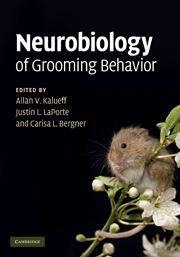Book contents
- Frontmatter
- Contents
- List of contributors
- Preface
- 1 Grooming, sequencing, and beyond: how it all began
- 2 Self-grooming as a form of olfactory communication in meadow voles and prairie voles (Microtus spp.)
- 3 Phenotyping and genetics of rodent grooming and barbering: utility for experimental neuroscience research
- 4 Social play, social grooming, and the regulation of social relationships
- 5 Grooming syntax as a sensitive measure of the effects of subchronic PCP treatment in rats
- 6 Modulatory effects of estrogens on grooming and related behaviors
- 7 Lack of barbering behavior in the phospholipase Cβ1 mutant mouse: a model animal for schizophrenia
- 8 Grooming after cerebellar, basal ganglia, and neocortical lesions
- 9 Striatal implementation of action sequences and more: grooming chains, inhibitory gating, and the relative reward effect
- 10 An ethological analysis of barbering behavior
- 11 Should there be a category: “grooming disorders?”
- 12 Neurobiology of trichotillomania
- Index
- References
8 - Grooming after cerebellar, basal ganglia, and neocortical lesions
Published online by Cambridge University Press: 04 August 2010
- Frontmatter
- Contents
- List of contributors
- Preface
- 1 Grooming, sequencing, and beyond: how it all began
- 2 Self-grooming as a form of olfactory communication in meadow voles and prairie voles (Microtus spp.)
- 3 Phenotyping and genetics of rodent grooming and barbering: utility for experimental neuroscience research
- 4 Social play, social grooming, and the regulation of social relationships
- 5 Grooming syntax as a sensitive measure of the effects of subchronic PCP treatment in rats
- 6 Modulatory effects of estrogens on grooming and related behaviors
- 7 Lack of barbering behavior in the phospholipase Cβ1 mutant mouse: a model animal for schizophrenia
- 8 Grooming after cerebellar, basal ganglia, and neocortical lesions
- 9 Striatal implementation of action sequences and more: grooming chains, inhibitory gating, and the relative reward effect
- 10 An ethological analysis of barbering behavior
- 11 Should there be a category: “grooming disorders?”
- 12 Neurobiology of trichotillomania
- Index
- References
Summary
Summary
Electrical stimulation of the midline cerebellum and striatum elicits grooming in rats. Lesioning methods with either surgery or genetic mutations indicate that these brain regions contribute to grooming behaviors. Grid2Lc mutant mice with selective cerebellar atrophy and Girk2Wv mutants with combined cerebellar and substantia nigra atrophy display different effects on grooming. While Grid2Lc mutants were affected in grooming completion but not serial ordering, the reverse was true in Girk2Wv mutants. Our results implicate cerebello–neocortical pathways in the completion of grooming chains, and a striato–pallido–neocortical pathway in the serial ordering of grooming chains.
Introduction and methodological considerations
The role of the cerebellum and basal ganglia on grooming is of some importance considering that grooming implies movement. It is therefore expected that part of the neural circuitry underlying grooming involves some aspect of motor function. In view of the importance of the cerebellum and basal ganglia in balance and posture (Lalonde and Strazielle 2007a), there is a special challenge in interpreting lesion effects of these brain regions on grooming. This is achievable by measuring serial ordering of grooming sequences. It is well established that rodents groom in a cephalocaudal order, anterior before posterior body parts (Richmond and Sachs 1980; Sachs 1988). Different types of grooming components may also be measured, such as face washing; licking of forelimbs, abdomen, back, and hindlimbs; as well as body shaking and scratching (Vanderwolf et al. 1978). Lesions may selectively affect some grooming components in a fashion inexplainable by motor deficits.
- Type
- Chapter
- Information
- Neurobiology of Grooming Behavior , pp. 145 - 155Publisher: Cambridge University PressPrint publication year: 2010



